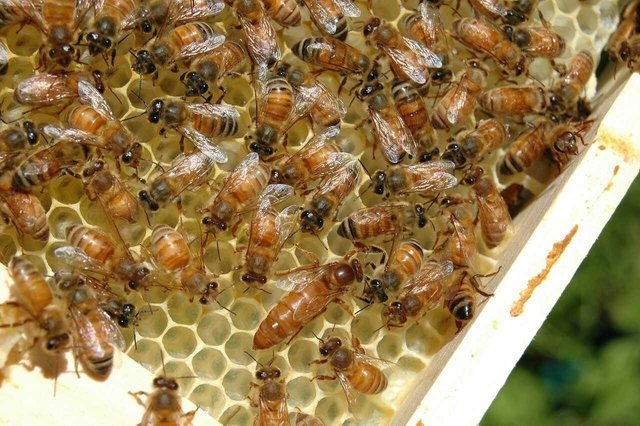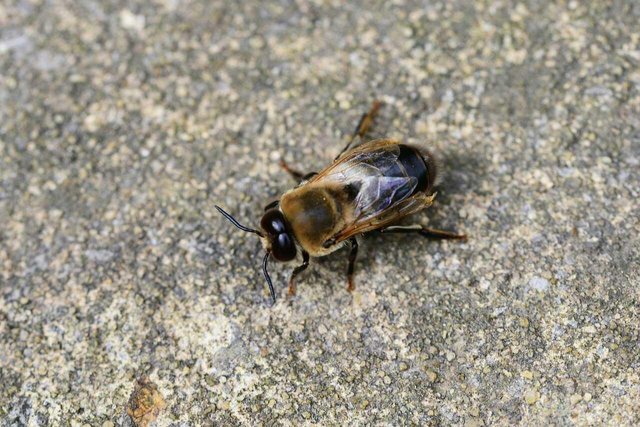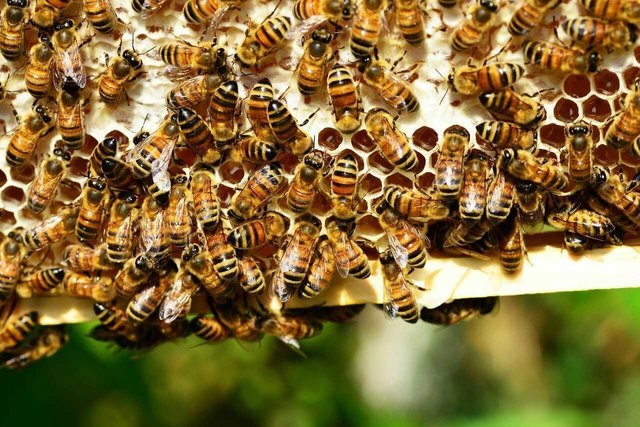Bee Keeping As An Agro Forestry Practice
Bee keeping can be defined as the manipulation of honey bees by man for the purpose of honey production and other hive products such as bee wax, pollen, propolis, royal jelly and venom and for the pollination of agricultural and other plants.
(A)Species Of Bees
There are several known species of bees. But species belonging to the genus Apis (the honey bees) are exploited by man for their products and for their pollinatory activities. There are four species in the genus Apis, three (3) are native to Asia and one is native to the Euro – African region. All of them are similar in appearance but their sizes and colors differ. Not all bees are social; they are solitary, semi social and eu – social. The four species are as follows:
(i) Apis mellifera (African Bees, old oriental): these are the species of bees presently employed in beekeeping in Nigeria because they are the most widespread economic species in west Africa particularly in Nigeria. It is scientifically recognized as Apis mellifera adanosonia. It is a good honey producer, pollinates crops excellently, have a gentle temper and their queen are good layers.
(ii) Apis cerana (Asian Bees): This species yield small quantities of honey compared with others and its hives are often smaller. However, it is more resistant to some of the diseases and pests found among other species.
(iii) Apis florae (The little bee): It is found in Asia and is very small in size. It usually builds a small single comb (nest) on the twig of a shrub or tree.
(iv) Apis dorsata (Rock or giant bee): They are native to Asia. They build a single comb, lives in exposed nests and will not live inside a hive. Its behavior is unpredictable yielding to difficulty in rearing such bees.
(B) Bee Ecology
Climate and vegetation affects honey production through their effect on nectar flow.
(i) Nectar flow: Is totally dependent on the plant. It refers to the quality and quantity of nectar secreted by the plant.
(ii) Honey flow: Is a function of the bee – plant relationship i.e. the use of the nectar flow by the honey bee colony.
(C) Bee Castes
The bee colony is composed of three different types of individuals or castes namely: a queen, drones and workers;
(i) The Queen: There is only one queen in the colony at a point in time. It is the only female that is completely developed sexually as a result of a total diet of royal jelly (bee milk) being fed to her during the developmental periods. Her purpose in life is to lay eggs (about several Hundreds of eggs in a day). It takes sixteen days (16) for the queen to develop from an egg to an adult. From 5 to 7 days after emergence from her cell, she takes a series of mating flights, mating with one or more drones. She stores the sperm in her spermatheca for subsequent fertilization of eggs; the eggs hatch and develop to become drones, workers or new queen. She lays only the type of egg that she feels that the colony needs. The queen is larger than the worker, and longer than the drone. She lives up to 4 years.

Image source.
(ii) The drones: The population of drones in a colony varies seasonally, depending on how much food the worker bees are able to gather for the colony during the nectar flow period. Drones are the male bees in the hive. Their only function in life is to mate with virgin queen during the mating flight outside the hive. The drone dies after mating with the queen. They are larger and fatter than the queen or the worker. They have short tongues which they use to take food from workers and store honey in the hive. Drones do not have legs fit to carry pollen and are unable to produce wax. Their eyes are large and cover practically the whole head. The end of their abdomen is blunt and covered with a tuft of small hairs. They do not have stings and do not take part in the workers duties. There are only a few hundreds of them in a colony.

Imagine source.
(iii) The workers: The workers are more numerous that other individuals in the colony. They are females which are not fully developed sexually. It takes 21 days for a worker to grow from egg to adult. They perform various tasks both in the colony and on the field.

Image source.
Some of their duties include:
Maintaining the hive in good condition by cleaning of cells and warming the brood nest.
Feeding older larvae with honey and pollen.
Using their wax glands under their abdomen to produce wax.
Using their long tongue to gather nectar.
They construct the comb.
Foraging for nectar pollen, water and Propolis.
(D) Behavioral Pattern of Bees
(i) Absconding: Is the abandoning of a nest site by a colony due to excessive disturbance of the colony by predators, bad management by the bee keeper, diminishing resources in an area or to escape sudden danger or death.
Supersedure: Refers to queen replacement without colony divisions. If the old queen’s production of eggs starts to dwindle, the worker bees will construct queen cells to rear a replacement. In supersedure, the old queen does not leave the colony, the new queen mates, returns to the colony and begins to lay eggs.
(ii) Swarming: is a natural colony division or reproduction in which a separate group of bees with one or more queens, ten thousand or more worker bees, and some drones leaves the colony to settle in a new site.
(iii)Communication: bees produce alarm pheromone in quick succession as a means of alerting others of a pending danger. The bee dance is used in communicating information on a good nectar source or new nesting site to other bees. The dance takes place on the comb in a pattern that indicates the direction, distance and quality of the source.
(iv) Nest Odour: Every bee colony has a nest odour. Any bee from another colony may not be allowed to enter a particular nest (except it is carrying nectar).
(v) Colour attraction: when bees are provoked, they are more easily attracted to dark outfits or objects than to bright coloured objects. Therefore white and coloured clothings should be worn by the beekeepers.
Bee stings: Any intending beekeeper should accept the fact that it would only be normal and a part of the practice to be stung by the bee. There is a saying that “if you can afford the sting of the bee, you will escape the sting of poverty”. The essence of the protective clothing is to reduce the incidence to a bearable minimum.
(E) Basic Needs By Bees
There are four basic needs of a strong colony, these are:
Nectar
Pollen
Shelter/home
Water
(i) Nectar: is a sugary secretion of the plants which is 60 – 80% water. It is the carbohydrate or energy component in the diet of the bees. Workers take the nectar from the flowers, carry it in their honey stomach (social crop), pass the nectar to younger workers back to their nest, who converts it into honey and stores it in cells.
(ii) Pollen: is the powdery material found in flowers naturally use for pollination and fertilization to produce seeds in plants. Pollen is an important source of protein for feeding the developing larvae (brood).
(iii) Home/Shelter: the bee home is called a hive; In beekeeping a home for the bees is crucial. It is needed as a place for the bees to raise their young ones, build their wax comb, store their pollen and nectar, and also for protection from wind, rain, heat, cold, pests or other forms of danger.
(iv) Water: A close source of fresh water is helpful to bee colony. Water is needed for cooling the hive on hot days and the bees also use it to mix honey before they can feed on it.
(F) Some Tools/Equipment Used In Beekeeping
For an efficient honey production technology, the beekeeper should be fully equipped with all the necessary tools:
Hives
Smokers
Honey extractors
Water sprayer
Wax extractor
Veil/Hat
Clothing/bee Suit (always white)
Bee brushes
Harvesting knife
(G) The Products of the Hive And Their Uses;
Honey
Pollen
Bee wax
Royal jelly
Propolis
Bee venom
(i) Honey: is a sweet substance transformed by bee mainly from nectars, the tastes and properties of honey (in its original form) depends on the flower source of the nectar. Generally dark looking honey tastes stronger. Honey is basically carbohydrate, readily assimilated by the body and is a quick source of energy to man.
Uses of Honey
Used as sugar substitute in cooking, baking, drinks and beverages.
It is used to produce cosmetic in cosmetic industries.
It is a preferable sweetener for diabetic patients.
(ii) Pollen: the fine dust – like substance which is the male reproductive cell of flowering plants, they are collected by bees as a source of protein in the production of honey.
Uses of Pollen
Serves as a source of protein to the bees.
It can be stored as bee – bread In the cells of the honey comb and
Source of food to the young bees.
(iii) Bee Wax: they are wax produced by the honey bees through a special gland on the underside of bees (from worker bees only) which is then used to build comb
Uses of Bee Wax
Used in the production of materials like candle.
Used to free frozen nuts.
Used in the production of food, cosmetic and pharmaceutic
(H) Conditions For Siting An Apiary
(i)Nectar and pollen source
(ii)Water
(iii)Protection from sun
(iv)Protection from wind and rain
(v) Accessibility
(vi) Location
All images are credited to pixabay
Informative reading about me.
Thanks @simaoatb.
Keeep posting good materials.
Congratulations @simaoatb! You have completed some achievement on Steemit and have been rewarded with new badge(s) :
Click on any badge to view your own Board of Honor on SteemitBoard.
To support your work, I also upvoted your post!
For more information about SteemitBoard, click here
If you no longer want to receive notifications, reply to this comment with the word
STOPYour post has been upvoted by the @steemainsarena community trail. Our goal is to support minnows on steemit to help them grow. You can join our discord server here; https://discord.gg/zGvs8m
You can support us by donating steem/sbd or delegating sp to steemainsarena trail to acknowledge our mission.
Congratulations! This post has been upvoted from the communal account, @minnowsupport, by simaoatb from the Minnow Support Project. It's a witness project run by aggroed, ausbitbank, teamsteem, theprophet0, someguy123, neoxian, followbtcnews, and netuoso. The goal is to help Steemit grow by supporting Minnows. Please find us at the Peace, Abundance, and Liberty Network (PALnet) Discord Channel. It's a completely public and open space to all members of the Steemit community who voluntarily choose to be there.
If you would like to delegate to the Minnow Support Project you can do so by clicking on the following links: 50SP, 100SP, 250SP, 500SP, 1000SP, 5000SP.
Be sure to leave at least 50SP undelegated on your account.